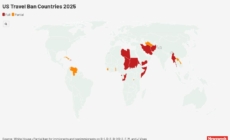-
Putin Suffers His Worst Week of 2025 - 6 mins ago
-
Trump Travel Order Bans People From 12 Countries From Entering U.S. - 39 mins ago
-
Joe Biden’s Doctor to Be Subpoenaed to Testify About Former President - 41 mins ago
-
Kyle Busch’s Lavish 15,000 Square Feet Home Goes on Sale at a Premium Price - about 1 hour ago
-
In War-Torn Nations, Trump’s Travel Ban Brings a New Hardship - about 1 hour ago
-
Tears as Dog Still Waits for Best Friend to Return—a Year After She Died - 2 hours ago
-
Tariffs Make the World Poorer and More Perilous - 2 hours ago
-
Andrew Cuomo Issues New Warning to Trump in NYC Mayoral Debate - 2 hours ago
-
Who Is Johnnie Moore? Here’s What to Know About a Gaza Aid Group’s Chairman. - 3 hours ago
-
Yankees Would Land Rival Star in 3-Player Trade Idea After Jazz Chisholm Jr. Return - 3 hours ago
Are the Russia-Ukraine Peace Talks Going Anywhere? | Opinion
On June 2, Russian and Ukrainian representatives met in Istanbul, Turkey, for the second round of peace talks in about two weeks. The initial round last month ended after 90 minutes with little progress outside of an agreement to release prisoners on both sides. All of the major political issues, such as establishing a ceasefire, Ukraine’s future foreign policy trajectory, and the disposition of Russian military forces inside Ukraine were kicked down the road to a later date.
This week’s talks ended in a similar fashion. Again, no movement was detected on the major issues that have fueled the war into a fourth year. Coming a day after Kyiv conducted its most impressive drone attack inside Russia since the war began, one that took out as much as a third of Moscow’s cruise missile carriers (one Russian commentator called the attack Russia’s version of Pearl Harbor), Moscow was in no mood to compromise. Much like the first round, the Ukrainians and Russians walked away pledging to work toward the release of all wounded prisoners of war and those under 25 years old. The timeline to actually achieve this, however, wasn’t spelled out.

Chris McGrath/Getty Images
If anybody was anticipating movement on the big disputes, then you were asking for too much. Merely getting to a point where Ukrainian and Russian officials could sit at the same table took an excruciating amount of time and effort, including an Oval Office dressing down of Ukrainian President Volodymyr Zelensky and bilateral conversations between the Americans and the Russians. Even then, it wasn’t easy; after Zelensky committed to talks, he and Russian President Vladimir Putin went back and forth about who they were going to send. In the end, Putin chose to skip the proceedings and ordered a lower-level Russian delegation to travel to Turkey, a snub to the Ukrainians, who viewed the presence of mid-level officials as a reflection of Moscow’s disinterest in diplomacy.
It only stands to reason that the substance of the negotiations would be just as complicated as entering the room in the first place—and in all likelihood more so. The Ukrainian and Russian delegations handed over their respective positions in writing, which is good news. But the bad news overpowers the good in this situation: the two sides are keeping to their maximalist objectives and don’t seem particularly interested in finding any overlap. This may change as the talks go on. Or it won’t, in which case the entire diplomatic edifice comes crumbling down and the war will enter a more feverish pace.
The pessimism is hard to shake. According to Reuters, the peace blueprint Ukraine delivered to Russia started off with a full ceasefire of 30 days, monitored by the United States and other third parties. Confidence-building steps, like prisoner exchanges and the repatriation of Ukrainian children taken during the war, would be the next step. The final peace deal would give Ukraine assurances that future Russian aggression would cease, namely through “robust” foreign-backed security guarantees. And Kyiv would have the freedom to join whatever political, economic, and military alliances it desires. While sanctions against the Russian economy would be lifted in the event of successful implementation, frozen Russian assets would still be earmarked for Ukraine’s post-conflict reconstruction.
The Russians have their own terms, and they couldn’t be any more different from Kyiv’s. The Russian term-sheet demands a full Ukrainian military withdrawal from Donetsk, Luhansk, Kherson, and Zaporizhzhia before a ceasefire takes place, which can only be interpreted as a ploy by Moscow to get the territorial concessions it hasn’t been able to achieve through force. Ukraine would be prohibited from joining military alliances, and foreign troops and infrastructure would be barred from the country as well. Ukrainian military power would be capped, all western sanctions against Russia would be lifted, and both sides would drop claims to financial restitution. None of this is surprising because Russian officials have talked about these demands previously. But Zelensky and his allies in Europe, and likely some of the more transatlantic-friendly members of the Trump administration, will find all of this unhelpful and a bad omen for future talks.
The big mystery now is where diplomacy goes from here. The answer depends on whether the initial proposals tabled by Ukraine and Russia are the typical opening offers we often see during high-stakes negotiations or ultimatums geared for public consumption. In other words, are the combatants at the first stage of genuine diplomacy? Or are they using the current bilateral talks as a way to embarrass each other, influence the court of world opinion to their advantage, and convince the elephant in the room, President Donald Trump, that it’s the other side obstructing his dreams of a Nobel Peace Prize?
If it’s the former, then we at least open the possibility of a conflict-ending solution—although a positive end-state still isn’t guaranteed. But if it’s the latter, then Trump will eventually grow tired of the charade, throw in the towel, and move on. The most frustrating aspect of this entire saga is that none of us truly know where this is all headed.
Daniel R. DePetris is a fellow at Defense Priorities and a syndicated foreign affairs columnist at the Chicago Tribune.
The views expressed in this article are the writer’s own.
Source link






















